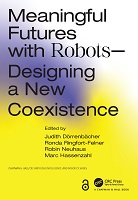Chapter 12 Design Fictio
Proposal review
The Future of Robots Needs Imagination
| dc.contributor.author | Ringfort-Felner, Ronda | |
| dc.contributor.author | Neuhaus, Robin | |
| dc.contributor.author | Dörrenbächer, Judith | |
| dc.contributor.author | Hassenzahl, Marc | |
| dc.date.accessioned | 2022-11-16T10:26:26Z | |
| dc.date.available | 2022-11-16T10:26:26Z | |
| dc.date.issued | 2023 | |
| dc.identifier.uri | https://library.oapen.org/handle/20.500.12657/59257 | |
| dc.description.abstract | What kind of robots do we want to live with in the future? Which ones do we not want? How will robots affect our everyday lives? What will be the consequences of our coexistence with them? Roboticists tend to focus on the product design of the robot, its exact configuration, and its technical implementation; rarely is any thought given to the far-reaching social consequences that might arise when a robot actually becomes part of our lives. So, this contribution is about how design can be used to imagine, visualize, and experience possible futures with the robots we want (or do not want). The authors introduce the design practices of Speculative Design and Design Fiction, discussing their practical applications and potential in the field of robotics. The authors offer several examples of Design Fiction projects that illustrate the use and utility of Speculative Design practices for robotic developers, researchers, and laypeople to discuss how the future of robots can be actively shaped through imagination and design. They then present a concrete tool for roboticists: A Design Fiction robot workshop where participants slip into the roles of various stakeholders to speculate about the future of mundane life with robots. | en_US |
| dc.language | English | en_US |
| dc.subject.classification | thema EDItEUR::U Computing and Information Technology | en_US |
| dc.subject.classification | thema EDItEUR::T Technology, Engineering, Agriculture, Industrial processes::TJ Electronics and communications engineering::TJF Electronics engineering::TJFM Automatic control engineering::TJFM1 Robotics | en_US |
| dc.subject.classification | thema EDItEUR::U Computing and Information Technology::UY Computer science::UYZ Human–computer interaction | en_US |
| dc.subject.other | a, aI, Coexistence, Designing, Dorrenbacher, Dörrenbächer, et, Felner, Futures, Hassenzahl, Judith, Marc, Meaningful, Neuhaus, New, Ringfort, Robin, Robots, Ronda | en_US |
| dc.title | Chapter 12 Design Fictio | en_US |
| dc.title.alternative | The Future of Robots Needs Imagination | en_US |
| dc.type | chapter | |
| oapen.identifier.doi | 10.1201/9781003287445-12 | en_US |
| oapen.relation.isPublishedBy | 7b3c7b10-5b1e-40b3-860e-c6dd5197f0bb | en_US |
| oapen.relation.isPartOfBook | 17bfd2cb-2e5a-4b89-8f97-bb379c40c420 | en_US |
| oapen.relation.isbn | 9781032262673 | en_US |
| oapen.relation.isbn | 9781032246482 | en_US |
| oapen.imprint | CRC Press | en_US |
| oapen.pages | 18 | en_US |
| peerreview.anonymity | Single-anonymised | |
| peerreview.id | bc80075c-96cc-4740-a9f3-a234bc2598f1 | |
| peerreview.open.review | No | |
| peerreview.publish.responsibility | Publisher | |
| peerreview.review.stage | Pre-publication | |
| peerreview.review.type | Proposal | |
| peerreview.reviewer.type | Internal editor | |
| peerreview.reviewer.type | External peer reviewer | |
| peerreview.title | Proposal review | |
| oapen.review.comments | Taylor & Francis open access titles are reviewed as a minimum at proposal stage by at least two external peer reviewers and an internal editor (additional reviews may be sought and additional content reviewed as required). |

